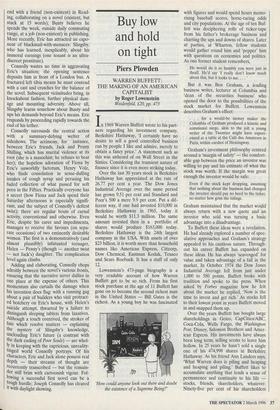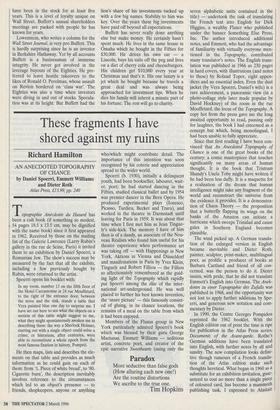Buy low and hold on tight
Piers Plowden
WARREN BUFFETT: THE MAKING OF AN AMERICAN CAPITALIST by Roger Lowenstein Weidenfeld, £20, pp. 473 In 1969 Warren Buffett wrote to his part- ners regarding his investment company, Berkshire Hathaway, 'I certainly have no desire to sell a good controlled business run by people I like and admire, merely to obtain a fancy price.' A statement such as this was unheard of on Wall Street in the Sixties. Considering the transient nature of finance since it is even more striking today.
Over the last 30 years stock in Berkshire Hathaway has appreciated at the rate of 26.77 per cent a year. The Dow Jones Industrial Average over the same period has grown 9.51 per cent and Standard and Poor's 500 a mere 9.9 per cent. Put a dif- ferent way, if one had invested $10,000 in Berkshire Hathaway in 1965, today it would be worth $11.3 million. The same amount invested then in a portfolio of shares would produce $163,000 today. Berkshire Hathaway is the 24th largest company in the USA. With assets of over $23 billion, it is worth more than household names like American Express, Citicorp, Dow Chemical, Eastman Kodak, Texaco and Sears Roebuck. It has a staff of only 12.
Lowenstein's 473-page biography is a very readable account of how Warren Buffett got to be so rich. From his first stock purchase at the age of 11 Buffett has gone on to become the second richest man in the United States — Bill Gates is the richest. As a young boy he was fascinated `How could anyone look out there and doubt the existence of a Supreme Being?' with figures and would spend hours memo- rising . baseball scores, horse-racing odds and city populations. At the age of ten Buf- fett was deciphering rolls of ticker-tape from his father's brokerage business and charting the ups and downs of shares. Later at parties, at Wharton, fellow students would gather round him and 'pepper' him with questions on economics and politics. As one former student remembers,
He would do it so humbly you were just in thrall. He'd say 'I really don't know much about this, but it looks to me.. .. '
But it was Ben Graham, a leading business writer, lecturer at Columbia and `dean of the securities business' who opened the door to the possibilities of the stock market for Buffett. Lowenstein describes Graham's effect: . . . for a would-be money maker the Columbia of Graham produced a kinetic and communal surge, akin to the jolt a young writer of the Twenties might have experi- enced at a table at the Café des Amateurs in Paris, within earshot of Hemingway.
Graham's investment philosophy centred around a 'margin of safety' — the comfort- able gap between the price an investor was willing to pay and his estimate of what the stock was worth. If the margin was great enough the investor would be safe:
Even if the stock kept dropping, assuming that nothing about the business had changed the investor should pay no heed to the ticker, no matter how grim the tidings.
Graham maintained that the market would always return with a new quote and an investor who sold was turning a basic advantage into a disadvantage.
To Buffett these ideas were a revelation. He had already explored a number of spec- ulative approaches and Graham's strategy appealed to his cautious nature. Through- out his career Buffett has expanded on these ideas. He has always 'scavenged' for value and taken advantage of a fall in the market. In October 1974 the Dow Jones Industrial Average fell from just under 1,000 to 580 points. Buffett broke with tradition and spoke to the press. When asked by Forbes magazine how he felt about the market he replied, 'Now is the time to invest and get rich.' As stocks fell to their lowest point in years Buffett moved in and snapped them up.
Over the years Buffett has bought large shareholdings in Geico, CapCities/ABC, Coca-Cola, Wells Fargo, the Washington Post, Disney, Salomon Brothers and Amer- ican Express. His investments have always been long term; selling seems to leave him hollow. In 25 years he hasn't sold a single one of his 474,998 shares in Berkshire Hathaway. As his friend Ann Landers says, `What Warren does is piling and heaping and heaping and piling.' Buffett likes to accumulate anything that lends a sense of permanence and continuity to his life stocks, friends, shareholders, whatever. Ninety-five per cent of his shareholders have been in the stock for at least five years. This is a level of loyalty unique on Wall Street. Buffett's annual shareholders meetings are packed with people he has known for years.
Lowenstein, who writes a column for the Wall Street Journal, is very pro Buffett. This is hardly surprising since he is an investor in Berkshire Hathaway. Yet by all accounts Buffett is a businessman of immense integrity. He never got involved in the leverage buyouts of the Eighties. He pre- ferred to leave hostile takeovers to the likes of Ronald 0. Perelman, whose assault on Revlon bordered on 'class war'. The Eighties was also a time when investors were diving in and out of stocks. Specula- tion was at its height. But Buffett had the lion's share of his investments tucked up with a few big names. Stability to him was key. Over the years these big investments have paid off beyond all expectations.
Buffett has never really done anything else but make money. He certainly hasn't spent much. He lives in the same house in Omaha which he bought in the Fifties for $30,000. He drives his own car — a Lincoln, buys his suits off the peg and lives on a diet of cherry cola and cheeseburgers. His children get $10,000 every year at Christmas and that's it. His one luxury is a jet which he bought because he travels a great deal and was always being approached for investment tips. When he dies his family will inherit a minute part of his fortune. The rest will go to charity.



































































 Previous page
Previous page